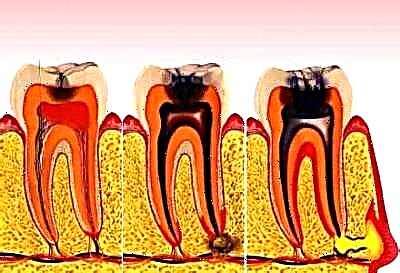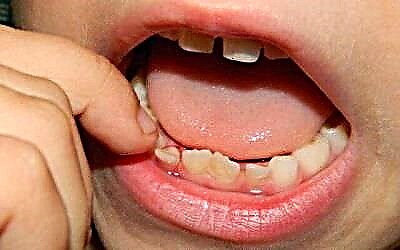
A child's gums can become inflamed or damaged due to various factors, such as teething, infection, or injury. Sometimes babies develop a lump that causes panic in their parents. What can such a change in the mouth of a daughter or son indicate and what should be done when it appears?

What does the appearance of a lump on the gum mean?
The most common are 2 reasons for the appearance of a mass in the form of a lump on the gums of a child:
- Untreated caries.
- Teething.
The most common factor provoking the formation of a lump on the gum is infection of a milk or permanent tooth with caries. Such a disease occurs due to poor hygiene, malnutrition and other factors, affecting the tooth enamel first. If untreated, deep tooth tissues are affected and an abscess may form, which is called a flux.
The toxins from the caries-infected pulp penetrate through the dental root into the gum. This provokes the appearance of an inflammatory process near the apex of the root, in which pus is formed. It requires going outside and collects under the mucous membrane of the gums next to the aching tooth. This forms a cyst with pus, which looks like a lump on the gum.

In infants and children of the second year of life, a lump on the gum may appear as a result of a new tooth erupting. It is called an eruption cyst, since such a cyst occurs in an infant before the appearance of a tooth, as a result of its advancement to the gum surface. Such a bump can be very painful and greatly disturb the crumb until the time of the teething.
Less common causes of gum bumps are:
- Tooth infection under a temporary seal.
- Jaw injury which caused the inflammatory process.

In what places can it appear and how it looks
Lumps can appear anywhere on the gum, especially if it is a sign of a cutting tooth. This bump can be seen on both the upper and lower jaw gums. Wherein most often it is provoked by a cutting chewing tooth. When canines or incisors are erupting, the appearance of a bump is much less common.
With gumboil, a bump often appears above the tooth and looks like a purulent, white, swollen area. If you touch it, the child will complain of pain. Gradually, the swelling rather quickly increases in size, which is why the baby feels bursting in the gums. Often joins such symptoms fever, deterioration in general condition, refusal to eat.
A bump that appears as a result of an injury is often represented by a hematoma, so it will have a dark color - burgundy, blue or purple-black. It can appear on any part of a child's gums, depending on the injured area.


What to do with a lump on the gum
Treatment for the lump on the gum will be determined based on the cause that caused it. That is why, when a bump appears on the child's gum, the first correct action of the parents should be a visit with a daughter or son to a dental clinic.
With flux
If a baby develops inflammation near the roots of a milk or molar tooth, it should certainly be treated by a dentist. The active formation of pus inside the gums increases the risk of lump rupture and the appearance of a fistulous canal in the gum tissue. Through it, pus can enter the mucous membrane of the mouth and tonsils, provoking frequent colds and sore throats. Even if the fistula heals on its own, it cannot be left untreated. As soon as the defenses in the toddler's body decrease, the inflammatory process is activated.
With a purulent lesion of a milk tooth, it is often removed so that the infection does not penetrate the rudiment of a permanent tooth. In addition, bacteria from the purulent lump can penetrate the lymph nodes located under the jaw, as a result of which their inflammation begins.

In some children, the penetration of toxins from the affected tooth tissues into the blood capable of provoking allergic reactions.
If a flux is found on a permanent tooth, the characteristics of its treatment will be determined by the degree of tooth decay. Sometimes a tooth can be saved, but in some cases, removal cannot be avoided, so it is important to prevent the development of flux in children over 6 years old so that they do not lose permanent teeth. You can not pull a visit to the dentist, and you should not use any alternative methods in the treatment of a purulent lump. As soon as a daughter or son has a gum formation, it is important to immediately go to the dentist.
When erupting
If the appearance of a bump is associated with a teething, then, as a rule, this situation does not require any action. It is not considered a problem and often disappears as soon as the tip of the crown of the tooth "pecks" through the gum. For complacency, parents should still show their child to a specialist so that the doctor confirms the absence of oral diseases.

In case of injury
If parents noticed a hematoma formed on the gums after falling or traumatizing the mucous membrane with any solid object, their actions should be determined by the size of this hematoma and the state of health of the crumbs.
With a slight blue discoloration, which does not bother the baby, they usually take a wait-and-see attitude. As a rule, in such situations, the hematoma will soon resolve itself. If the injury is strong enough and the swelling has dramatically increased its size, and the baby complains of pain, the baby should be immediately taken to a doctor.

What not to do
Having found a lump on the child's gum, parents should not:
- Try to open it yourself.
- Give your child any medication without a doctor's prescription.
- Stop brushing your child's teeth.
- Rinse your baby's mouth with hot broths.
- Apply a hot compress to the swollen area.
How to prevent
To prevent the appearance of a bump on the gums, it is recommended:
- Carefully monitor the child's oral hygiene.
- Start brushing your teeth from the moment the first tooth appears.
- Limit sweets on the child's menu.
- Regularly go with your baby for a checkup to the dentist.
- Treat caries in time.
- Do not let your child chew on sharp objects.




